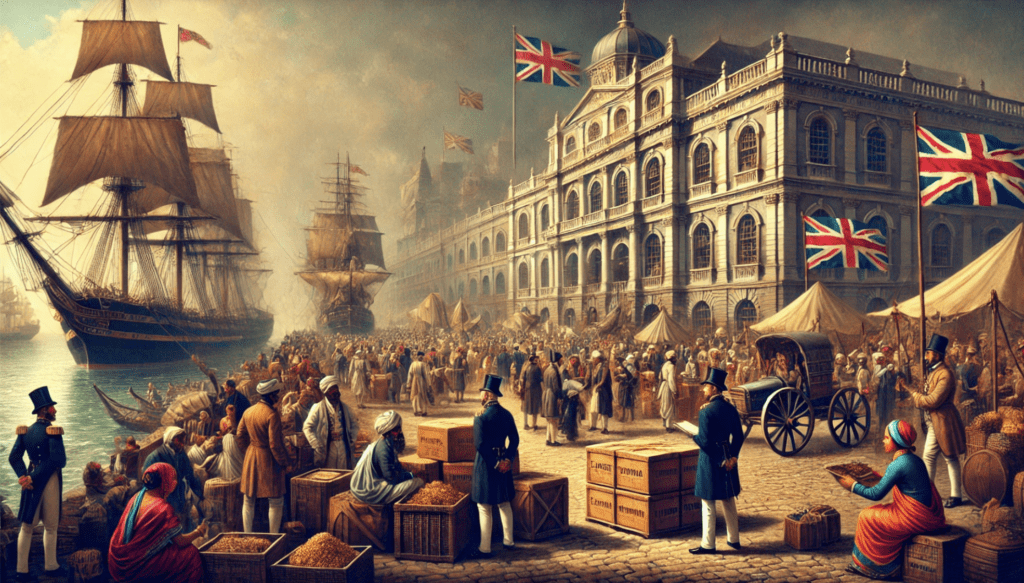The East India Company (EIC), often referred to as the British East India Company, stands as a monumental figure in the history of global trade.
With its:
- Extensive worldwide reach
- Pioneering administrative practices
- And significant economic, political, and cultural impact
the EIC set the stage for modern global commerce.
This article delves into the EIC’s evolution as a transnational corporation, how it functioned, and the profound effects it had on the world.
Origins and Early Years
The EIC was established on December 31, 1600, by a royal charter granted by Queen Elizabeth I.
This charter gave the company a monopoly over English trade with the East Indies (spanning the vast regions of modern-day South and Southeast Asia).
The initial capital of £72,000 was raised from over 200 investors, including:
- Nobles
- Merchants
- And gentry.
The company’s primary goal was to break the Portuguese and Spanish dominance in the spice trade and establish direct trading links with the East.
The early voyages of the EIC were perilous and fraught with challenges, from hostile encounters with rival traders to the harsh realities of long sea voyages.
Despite these obstacles, the company gradually secured footholds in various parts of India by establishing trading posts or “factories” in:
- Surat, Madras (now Chennai)
- Bombay (Mumbai)
- and Calcutta (Kolkata).
These factories served as pivotal centers for the company’s operations, facilitating the trade of:
- Spices
- Silk
- Cotton
- Tea
- And other valuable commodities.
Expansion and Consolidation of Power
The 17th and 18th centuries marked a period of significant expansion for the EIC.
As the EIC’s commercial activities grew, so did its political and military ambitions.
The company’s influence extended far beyond mere trade.
It began to engage in military and political activities, often leveraging its economic power to secure political influence.
The company’s expansion was often driven by the need to protect its trading interests, leading to numerous conflicts and engagements with local rulers and rival European powers.
This era saw the EIC transitioning from a commercial enterprise to a sovereign power.
One of the pivotal moments in the EIC’s history was the Battle of Plassey in 1757, where its forces, led by Robert Clive, defeated the Nawab of Bengal.
This victory marked the beginning of British dominance in India and established the EIC as a formidable political and military power.
The subsequent acquisition of the Diwani rights in 1765, granting the EIC the authority to collect revenues in:
- Bengal
- Bihar
- and Orissa
further solidified its power.
This fiscal control allowed the EIC to amass immense wealth, which it used to finance its operations and further its territorial ambitions.
The EIC’s ability to wield military force to secure and expand its interests was a defining characteristic of its transnational operations.
It maintained its own private army, which by the early 19th century numbered over 250,000 troops – significantly larger than the British Army at the time.
This military prowess enabled the company to:
- Exert control over vast territories
- Collect taxes
- And enforce its commercial policies.
Organizational Structure and Functioning
The EIC’s organizational structure was a testament to its innovative approach to business management.
It was governed by a Court of Directors based in London, comprising prominent merchants and investors who made strategic decisions and oversaw the company’s vast operations.
The Court of Directors appointed factors (agents) to manage individual trading posts and factories abroad, ensuring a degree of centralized control over decentralized operations.
The company’s ability to function as a transnational entity was further enhanced by its semi-autonomous nature.
The royal charter granted the EIC significant powers, including the right to:
- Mint money
- Negotiate treaties
- And maintain armed forces.
This autonomy allowed the company to operate with a level of flexibility and authority that was crucial for navigating the complex political and economic landscapes of its time.
One of the EIC’s most significant innovations was its use of joint-stock financing.
By raising capital from a broad base of investors, the company mitigated individual risk and pooled resources for large-scale ventures.
This model not only facilitated the EIC’s expansive operations but also laid the groundwork for modern corporate finance and the stock market.
Economic and Cultural Impact
The economic impact of the EIC on India and Britain was profound.
The company played a pivotal role in the global trade network, facilitating the exchange of:
- Goods
- Ideas
- And cultures.
The EIC’s trade activities contributed significantly to the British economy, fueling the growth of industries and the accumulation of capital that would later drive the Industrial Revolution.
In India, the EIC’s influence was a double-edged sword.
While the company’s investments in infrastructure, such as:
- Roads
- Ports
- And telegraph lines
contributed to the modernization of the Indian economy, its policies also led to economic disruption and social dislocation.
Traditional industries, such as textiles, faced severe decline due to competition with British manufactured goods, leading to widespread unemployment and poverty.
Culturally, the EIC served as a conduit for the exchange of knowledge and ideas between the East and the West.
The company’s officials and employees often engaged in the study of:
- Indian languages
- Literature
- And culture
contributing to fields of study.
The EIC also played a role in the introduction of Western education and legal systems in India, which had long-lasting impacts on Indian society.
Decline and Legacy
The 19th century witnessed the gradual decline of the EIC’s power.
The company’s administrative and military overreach, coupled with rising discontent among the Indian population, culminated in the Indian Rebellion of 1857.
This widespread uprising, also known as the Sepoy Mutiny, was a turning point in Indian history and marked the end of the EIC’s rule.
In the aftermath of the rebellion, the British government intervened, and the Government of India Act 1858 was enacted, which resulted in the dissolution of the EIC.
The British Crown assumed direct control over India, heralding the beginning of the British Raj.
Despite its dissolution, the legacy of the EIC endures.
The company’s:
- Impact on global trade
- Its role in the colonization of India
- And its contributions to cultural exchange
remain significant chapters in world history.
The EIC’s story is a complex tapestry of:
- Ambition
- Innovation
- And transformation
reflecting the multifaceted nature of global trade and its enduring effects on the modern world.
Conclusion
In conclusion, the East India Company was more than a mere trading enterprise – it was a formidable force that shaped the destiny of nations and left an indelible mark on history.
As the first transnational corporation, it laid the groundwork for the modern multinational enterprises that dominate today’s global economy.
Its history offers valuable lessons on the interplay between:
- Commerce
- Power
- And governance
highlighting both the potential and the perils of business expansion and influence on a global scale.
Main lessons:
- Establish strong positioning first
- Leverage your advantages for greater influence
- Keep centralized control over decentralized operations
- Autonomy allows you to operate with flexibility and navigate complexity
- Diversifying investments + pooling resources mitigates risk
- Overreach strains resources and legitimacy, leading to failure
Want to learn more about how to apply these principles to modern times?
You May Also Like:
InVideo.ai Review: The AI Video Tool That Turns You Into a Content Powerhouse (Or Just Another Overh...
The 5 Micro Sales You Must Master Before Closing Any Deal (Miss These and You'll Lose the Sale!)
The Billion-Dollar Bridge Formula: How to Build Your Own Profit Stream
The Psychology of Color in Branding: Choosing the Right Palette for Your Business
"What's The Best Online Niche Targeting Strategy?"
Unlocking the Power of Jungian Symbolism in Marketing
The Power of a Business Value Ladder: How to Build an Offer Stack that Converts
Effective Email List Building Strategies: A Comprehensive Guide
My name is Mister Infinite. I've written 600+ articles for people who want more out of life. Within this website you will find the motivation and action steps to live a better lifestyle.


